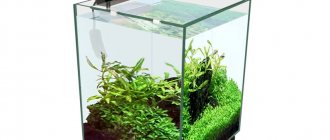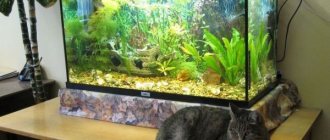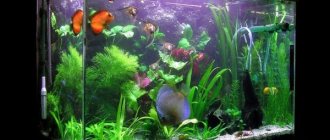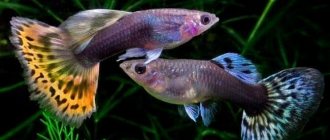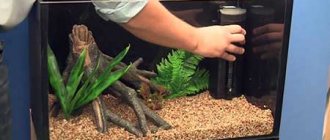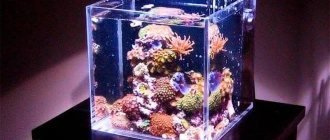In addition to the fact that a beautifully decorated aquarium is the dream of every indoor fish lover, it is also an original way to decorate a room. It can act both as a room decoration and serve as a stylish partition for zoning space. To turn this interior element into a real work of art, you need to familiarize yourself with the principles and styles of decorating an aquarium with your own hands.
Modern aquariums are not only a corner of wildlife, but a full-fledged work of art in your home
Choosing an aquarium
200-liter containers are usually made in a rectangular shape, but corner, wall-mounted and panoramic models can also be found on sale. The standard size of a 200 liter aquarium is 100x40x50 cm (LxWxH), glass thickness is 8 mm. The weight of an aquarium of this volume is 18-20 kg, and after filling with water it exceeds 200 kg.
When choosing a tank, you need to pay attention to its appearance. The container should not have cracks, scratches or chips; seams must be smooth and sealed. To ensure that the walls can withstand water pressure, stiffeners are installed.
Problems
One of the common problems associated with stones is the appearance of green or black deposits. This not only spoils the entire design, but also harms the inhabitants if nothing is done to eliminate it. Any experienced aquarist knows why this happens: stones and other objects, as well as the walls of the container, turn black or green for one reason - algae.
Blackening
Stones turn black not only for beginners, but also for experienced aquarists. Black plaque occurs due to the overgrowth of brown algae or diatoms. These uninvited guests also begin to coat the sides and other items in the container. The difficulty lies in the fact that first those stones that are located in darkened places turn black, so it is possible to detect the plaque quite late.
If stones turn black in your aquarium, pay attention to whether the conditions are being maintained. To eliminate black deposits, it is necessary to regularly change the water and control the lighting (stones often turn black in insufficient light). Another option is cleaner fish, but they will not be able to destroy all the plaque, so you will have to do the main work yourself. In addition to restoring the correct conditions, use a scraper to remove plaque from all accessible areas.
Equipment
Before buying a 200 liter aquarium, you need to prepare the place where it will stand. It should be remembered that not all furniture can support the weight of such a product, so it is recommended to purchase a special cabinet along with the pond. A sheet of foam material is placed between its surface and the bottom of the tank to smooth out any unevenness.
To maintain a comfortable environment for its inhabitants inside an artificial reservoir, the following equipment is used:
- filter – external, internal or mounted;
- compressor - in a 200-liter volume the installation of this device is mandatory;
- heater;
- lighting devices - a lamp with fluorescent or LED lamps, which can be built into the lid or placed separately above the cover glass.
Where to get them
- Natural reservoirs
- Pet stores
A pond is the best option where you can collect stones with your own hands, and as many as necessary. The water in them smoothes out all the sharp corners and irregularities that could injure the inhabitants of the aquarium. But you need to choose a body of water carefully: you should not take stones from those located next to quarries and mines for the extraction of minerals and metal ores.
If there are no suitable natural places nearby, or the stones in them are unsuitable, you can contact a pet store. Usually they are presented there in different versions: large and small, dark and light, unusual shapes, and even luminous stones for the aquarium. There you will select exactly the options that will help you create the necessary design and layout.
Return to content
Decor
The design of a 200-liter aquarium can either imitate the natural habitat of aquatic organisms or be decorative. It should be combined with the interior of the room. However, when designing an aquarium, it is necessary to take into account not only the desired appearance of the artificial reservoir, but also the needs of its inhabitants.
The background is attached to the back wall. Film backgrounds are fixed outside, and volumetric backgrounds are fixed inside the tank. Soil is laid at the bottom of the reservoir. The thickness of its layer and particle size depend on the needs of the plants that will be planted in the tank. Some species require a nutrient substrate.
The decorations used depend on the chosen aqua design. You can use natural objects (stones, driftwood) and artificial ones (caves, castles, ships, chests, etc.).
Original ideas
There are a lot of design ideas: bright toys at the bottom, tunnels made of stones and algae. The castle looks interesting in the aquarium. In the center they place an imitation of an island, a large piece of driftwood, or prepare handicrafts with their own hands. Less commonly, dry bamboo is used as decoration.
Looks like a living landscape, Taiwanese style. There are tall plants, figures, stones. Japanese offers a certain shape, size, number of objects. They use stones, wood, Java moss, sand as a symbol of the sky. An additional decoration is the beautiful lighting.
The famous aquascape designer and photo artist from Japan Takashi Amano uses exclusively natural materials and living plants, microorganisms, and fish in his ideas for an aquarium.
An aquarist is able to create a jungle, a winding path, a fallen tree, the shore of a wild lake, or a stream in an artificial reservoir. There are multi-layered soil, stones, driftwood, and plants. There are few or very small fish.
Plants
A 200-liter pond is suitable for growing large, long-stemmed and flowering plants. Species with elongated shoots and leaves, as well as those characterized by a high growth rate, are planted along the back wall and in the corners of the tank. Medium-sized plants and slow-growing species are placed in the center. Ground cover and low-growing plants are placed in the foreground. Driftwood and stones can be decorated with moss, secured with fishing line. Floating plants are used to create diffuse lighting. It should be remembered that some types of plants require the supply of carbon dioxide and fertilizer.
Use of stones
Stones are an important design element. Large ones (about the size of a fist) are used to secure structures made of small pebbles, since otherwise they will be leveled by water and animals.
A possible option for decorating an aquarium with stones
One can be placed at the top of the largest hill, and the smaller ones can be placed at the bottom.
How many and what kind of fish can you keep in a 200 liter aquarium?
A 200-liter aquarium is suitable for keeping both 1-2 large fish and schools of several dozen small fish. The number of hydrobionts directly depends on their size. Thus, fish up to 4 cm in size require 1-2 liters of water per 1 individual, species 6-10 cm in size - 8-10 liters of water per 1 individual, fish 11-20 cm in size - 15-20 liters of water per 1 individual. In this case, the individual characteristics of each species should be taken into account. Tall-bodied fish require more water than specimens with an elongated body. Predatory, large and territorial fish are kept in pairs or alone.
When selecting species for a community aquarium, the behavioral and nutritional characteristics of the fish are taken into account. Aggressive fish should not be mixed with timid ones, slow ones with active ones, and predators with small species that they will perceive as prey.
The following types of fish can be kept in a 200 liter aquarium:
- Barbs. These are lively, mobile fish ranging in size from 5 to 35 cm depending on the species; the size of most barbs does not exceed 10 cm. They are kept in flocks of at least 6-10 pieces; When kept in smaller numbers, barbs become aggressive and bully other fish. The aquarium requires thickets of plants combined with open spaces for swimming.
- Gourami. These are labyrinth fish no larger than 10 cm in size. They are unpretentious, but prefer warm water (25-27°C), so it is necessary to place a heater in the aquarium. Be sure to cover the tank with a lid or cover glass to prevent the fish from jumping out and getting sick after inhaling too cold air.
- Telescopes. This is a selected form of goldfish, characterized by a short body and enlarged bulging eyes. In an aquarium, telescopes grow up to 15-20 cm in length. Fish easily injure the eyes, so soil particles and decorations should not have sharp corners. Telescopes prefer temperatures of 18-22°C and low currents.
- Cichlids. Representatives of this family have different sizes (from 2.5 to 80 cm), body shape (from elongated cylindrical to laterally compressed and round) and behavior. Among these fish there are both peace-loving species (for example, discus fish) and aggressive and territorial ones (most cichlids). Therefore, a large number of hiding places should be placed in an aquarium with cichlids.
- Ancistrus catfish. These catfish reach a length of 15 cm. They lead a predominantly bottom-dwelling lifestyle; They swim poorly, but with the help of a mouth transformed into a suction cup, they can attach themselves to vertical surfaces - glass, decorations, wide plant leaves. In a community aquarium, they should be fed with special algae tablets.
- Goldfish. The size of goldfish in an aquarium is from 10 to 30 cm, depending on the breed. Representatives of this species like to dig the soil, so its particles must be smooth and large enough so that the fish cannot swallow them. Good filtration and aeration are required, as well as weekly water changes. Comfortable temperature – 15-20°C.
- Angelfish. The body length of the angelfish is 15 cm, and the height is 25-30 cm due to the long dorsal and anal fins. These calm and peaceful cichlids are kept in small groups. Species similar to the angelfish in character and size are selected as neighbors. These cichlids are predators and can eat small fish and fry.
Wooden decorative elements
Wood is popular as a decoration for a pond. For example, branches and roots of hazel, elm, maple, beech, ash. It is better not to take coniferous species, they rot and favor the growth of bacteria. Oak is also not suitable, it releases harmful substances in the water.
The selected piece of wood is cleaned of dirt and bark, then boiled for 30 minutes in salt water. Holes are made and the edges are burned. Keep the resulting product in cold water for a week, while changing the liquid every day. Fixed at the bottom.
The driftwood is steamed in a strong salt solution (2-2.5 kg and 10 liters of water) for three hours over low heat. Then they lower it to the bottom, tying a load, after 2-3 days the tree will become heavier and will not float up.
Artificial wood also looks realistic and is made from polymer resins.
Other inhabitants
You can also keep other aquatic inhabitants in a 200 liter aquarium. Freshwater shrimp get along well with fish; they collect uneaten food residues from the ground and destroy algae. Some varieties of these arthropods are painted in bright colors - red, blue, yellow, green. Also, crayfish are suitable for an aquarium of this size, but as neighbors for them you should select large fish that these arthropods cannot hunt. It is useful to introduce snails into the aquarium, which will eat excess food. In addition, frogs can live in the reservoir - clawed frogs and hymenochirus.
Starting and maintaining an aquarium
The purchased aquarium, decorations and soil are thoroughly washed. After installing the container, the substrate is poured into the prepared area and decorative elements are placed. Next, install the equipment - filter, compressor, heater. Then the aquarium is filled with water. Turn on the equipment and leave it running around the clock. After 3-7 days, plants are planted; at the same time, turn on the lighting, gradually increasing the duration of daylight hours. After 1-2 weeks, shellfish and unpretentious fish are released.
Caring for a 200-liter aquarium consists of weekly replacement of 20-30% of the volume with fresh water. As it gets dirty, siphon the soil and wash the filter, and also clean the glass. Overgrown plants are trimmed and thinned out every few months.
Tree
Wooden objects and roots often have very interesting shapes. Spread driftwood is great for highlighting key elements. Before placing this decoration in your chosen aquarium, it should be cleaned and boiled in water with a lot of salt or in a weak solution of manganese, and then cooled.
Aquarium decor with wood
Individual roots are perceived by the eye as lines. Designers use lines to direct the eye to a specific point. In a regular or corner aquarium, the main mound will immediately attract attention if you place driftwood to the right and left of it so that most of the “fingers” point in its direction. It's even better to install wooden decorations diagonally. This will be unexpected and interesting, since people are accustomed to seeing objects located horizontally and vertically.

